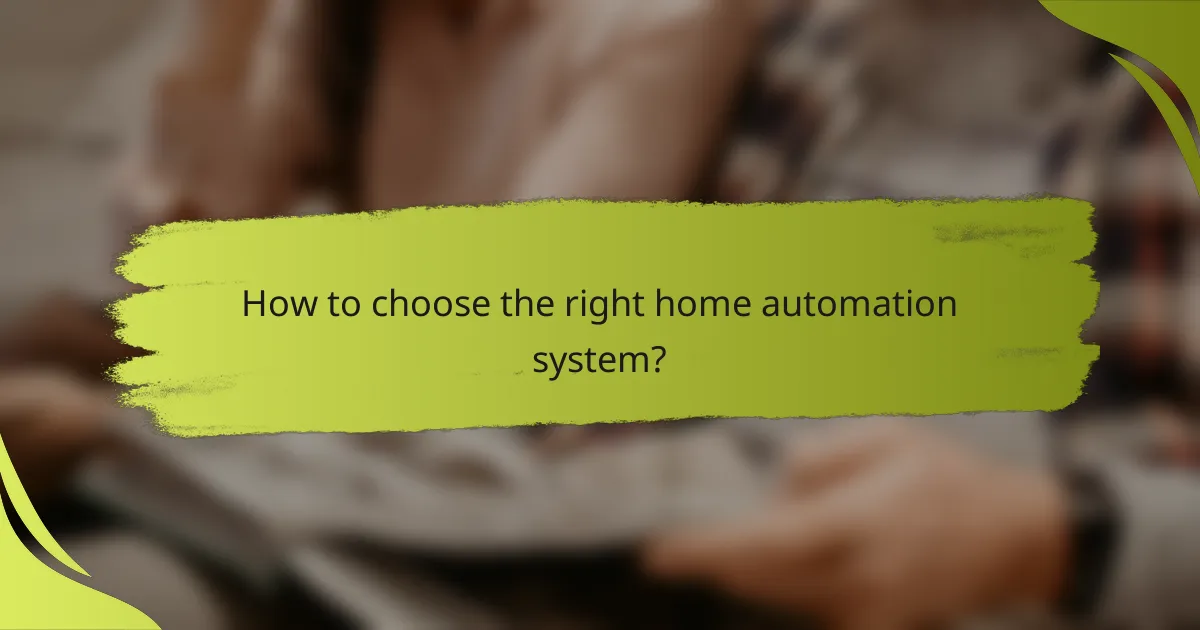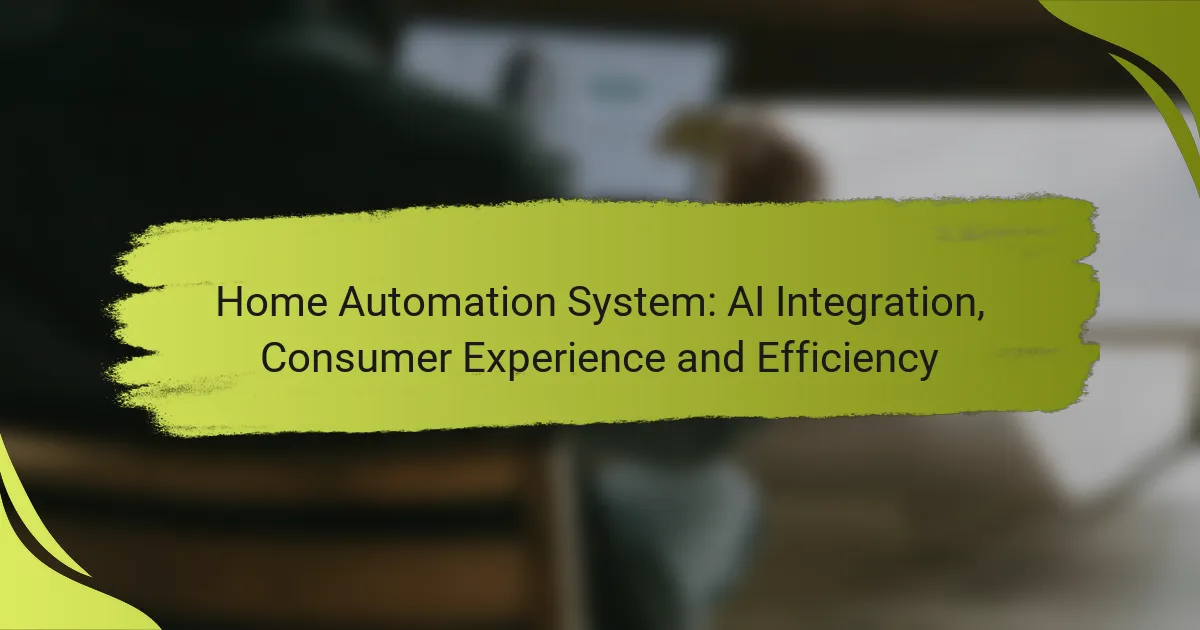The integration of AI in home automation systems revolutionizes the way we interact with our living spaces, offering enhanced energy efficiency and a more personalized user experience. By allowing remote accessibility and improved security features, these systems create a smarter environment tailored to individual needs. In India, such innovations significantly elevate consumer convenience and control, leading to greater comfort and energy savings.

What are the benefits of AI integration in home automation systems?
AI integration in home automation systems offers significant advantages, including enhanced energy efficiency, improved user experience, increased security features, personalized automation, and remote accessibility. These benefits collectively create a smarter, more responsive living environment that adapts to individual needs and preferences.
Enhanced energy efficiency
AI-driven home automation systems optimize energy consumption by learning user habits and adjusting settings accordingly. For instance, smart thermostats can analyze patterns and adjust heating or cooling to minimize energy use during unoccupied hours, potentially reducing energy bills by 10-30%.
Additionally, AI can manage lighting systems by automatically turning off lights in unoccupied rooms or adjusting brightness based on natural light availability. This not only saves energy but also prolongs the lifespan of lighting fixtures.
Improved user experience
AI enhances the user experience by providing intuitive interfaces and personalized interactions. Voice-activated assistants can respond to commands, control devices, and provide information, making home management seamless and convenient.
Moreover, machine learning algorithms can adapt to user preferences over time, suggesting routines or automating tasks based on individual habits, which increases overall satisfaction with the system.
Increased security features
AI integration significantly boosts home security through advanced monitoring and alert systems. Smart cameras can use facial recognition to identify familiar faces and alert homeowners to unusual activity, reducing false alarms.
Additionally, AI can analyze data from various sensors to detect anomalies, such as doors left ajar or unusual movements, and notify homeowners or authorities in real-time, enhancing overall safety.
Personalized automation
AI allows for highly personalized automation tailored to individual lifestyles. Users can set specific preferences for lighting, temperature, and appliance usage, which the system learns and adjusts automatically.
For example, a family might prefer different lighting settings for movie nights versus dinner parties, and AI can remember these preferences to create the ideal atmosphere without manual adjustments.
Remote accessibility
AI-integrated home automation systems offer remote access through mobile applications, allowing users to control their homes from anywhere. This capability enables homeowners to monitor security cameras, adjust thermostats, or turn off appliances while away, providing peace of mind.
Furthermore, many systems support notifications and alerts, keeping users informed about their home’s status, which is particularly useful for managing energy use and security when traveling or at work.

How do home automation systems improve consumer experience in India?
Home automation systems significantly enhance consumer experience in India by providing convenience, efficiency, and personalized control over household devices. These systems allow users to manage their homes remotely, leading to increased comfort and energy savings.
Intuitive user interfaces
Intuitive user interfaces are crucial for the effective use of home automation systems. They simplify navigation and control, allowing users of all ages to operate their devices easily. Many systems in India feature mobile apps with user-friendly designs that enable quick access to settings and functions.
When selecting a home automation system, look for interfaces that offer customizable dashboards and clear icons. This can help reduce the learning curve and enhance overall satisfaction.
Voice control options
Voice control options are increasingly popular in home automation, allowing users to operate devices hands-free. In India, systems often integrate with local language support, making it easier for non-English speakers to interact with technology. This feature enhances accessibility and convenience.
Consider systems compatible with popular voice assistants like Google Assistant or Amazon Alexa, as they can provide a more seamless experience. Ensure that the voice recognition works well in your environment to avoid frustration.
Seamless device integration
Seamless device integration is essential for a cohesive home automation experience. Systems that support a wide range of devices—from lighting to security cameras—allow for centralized control, enhancing user experience. In India, compatibility with local brands and products is vital for effective integration.
When choosing a system, check for compatibility with existing devices and future expansions. This can save time and money while ensuring that all components work together efficiently.
Localized support and services
Localized support and services play a significant role in the consumer experience of home automation systems in India. Access to local customer service can help users troubleshoot issues quickly and effectively. Many providers offer installation and maintenance services tailored to regional needs.
Look for companies that provide comprehensive support in your area, including installation assistance and customer service in local languages. This can greatly enhance the usability and reliability of your home automation system.

What are the top home automation systems available in India?
Some of the leading home automation systems in India include Google Nest, Amazon Echo Plus, Philips Hue, and Wink Hub 2. These systems offer various features that enhance convenience, security, and energy efficiency in homes.
Google Nest
Google Nest is a versatile home automation system that integrates seamlessly with Google Assistant. It allows users to control smart devices, manage schedules, and receive alerts through voice commands or the Google Home app.
Key features include smart thermostats, security cameras, and doorbells. Users should ensure compatibility with their existing devices and consider the initial setup cost, which can vary based on the number of devices integrated.
Amazon Echo Plus
The Amazon Echo Plus serves as a smart speaker and hub, enabling users to control compatible smart home devices using Alexa. Its built-in Zigbee hub simplifies the connection process for various devices.
Consider the Echo Plus for its sound quality and extensive Alexa skills. Users should be aware of potential privacy concerns and regularly review device permissions to maintain security.
Philips Hue
Philips Hue specializes in smart lighting solutions, allowing users to customize their home ambiance with a wide range of colors and brightness levels. The system can be controlled via the Philips Hue app or voice commands through compatible assistants.
When using Philips Hue, consider the cost of bulbs and the Hue Bridge for full functionality. It’s a great option for those looking to enhance their home’s aesthetic and energy efficiency.
Wink Hub 2
Wink Hub 2 is a central hub that connects various smart devices from different brands, providing a unified control platform. It supports multiple protocols, including Zigbee and Z-Wave, making it highly versatile.
Users should evaluate their existing devices for compatibility and consider the subscription model for advanced features. Wink Hub 2 is ideal for those wanting to manage a diverse range of smart home products from a single interface.

How to choose the right home automation system?
Choosing the right home automation system involves assessing compatibility with your existing devices, evaluating the user interface, considering scalability options, and reviewing customer support. These factors will help ensure that the system meets your needs and integrates seamlessly into your home environment.
Assess compatibility with existing devices
Before selecting a home automation system, check its compatibility with your current devices. Most systems work with a range of products, but some may only support specific brands or protocols like Zigbee or Z-Wave.
Make a list of your existing smart devices, such as lights, thermostats, and security cameras, and verify that the new system can control them. This will prevent the need for additional purchases or replacements, saving you money and effort.
Evaluate user interface and ease of use
A user-friendly interface is crucial for a positive experience with your home automation system. Look for systems that offer intuitive controls, whether through mobile apps, voice commands, or physical remotes.
Consider testing the interface in-store or through online demos. A system that is easy to navigate will minimize frustration and encourage regular use, enhancing your overall satisfaction.
Consider scalability options
Scalability is an important factor when choosing a home automation system. Opt for systems that allow you to easily add new devices or features as your needs evolve over time.
Some systems offer modular components, while others may require a complete overhaul for expansion. Assess your future plans for home automation to ensure your choice can grow with you.
Review customer support and warranty
Reliable customer support can make a significant difference when issues arise with your home automation system. Research the level of support offered, including availability of online resources, phone assistance, and community forums.
Additionally, check the warranty terms. A good warranty can protect your investment and provide peace of mind, especially for more expensive systems. Aim for warranties that cover at least one to two years for best value.

What are the installation costs for home automation systems in India?
The installation costs for home automation systems in India can vary significantly based on the complexity and scale of the system. Generally, homeowners can expect to spend anywhere from INR 20,000 to INR 1,50,000 or more, depending on the features and technology chosen.
Factors Influencing Costs
Several factors can influence the installation costs of home automation systems in India. The type of system—whether it is a basic setup or a comprehensive solution—plays a crucial role. Additionally, the number of devices, the brand of equipment, and the complexity of installation can all affect the final price.
For instance, a simple smart lighting system may cost less than INR 30,000, while a full-fledged home automation system that includes security, climate control, and entertainment can exceed INR 1,00,000. It’s essential to evaluate your specific needs and budget before making a decision.
DIY vs. Professional Installation
Choosing between DIY installation and hiring professionals can significantly impact costs. DIY options are generally more affordable, with basic kits available for under INR 15,000. However, they may require technical knowledge and time to set up properly.
On the other hand, professional installation ensures that the system is set up correctly and can cost anywhere from INR 10,000 to INR 50,000, depending on the complexity. It’s advisable to weigh the potential savings against the benefits of expert installation.
Long-term Considerations
When budgeting for a home automation system, consider long-term costs such as maintenance, upgrades, and energy savings. Some systems can lead to reduced energy bills, which may offset initial installation costs over time.
Additionally, factor in the potential need for future upgrades as technology evolves. Investing in a scalable system can save money in the long run, as it allows for easy additions without a complete overhaul.
